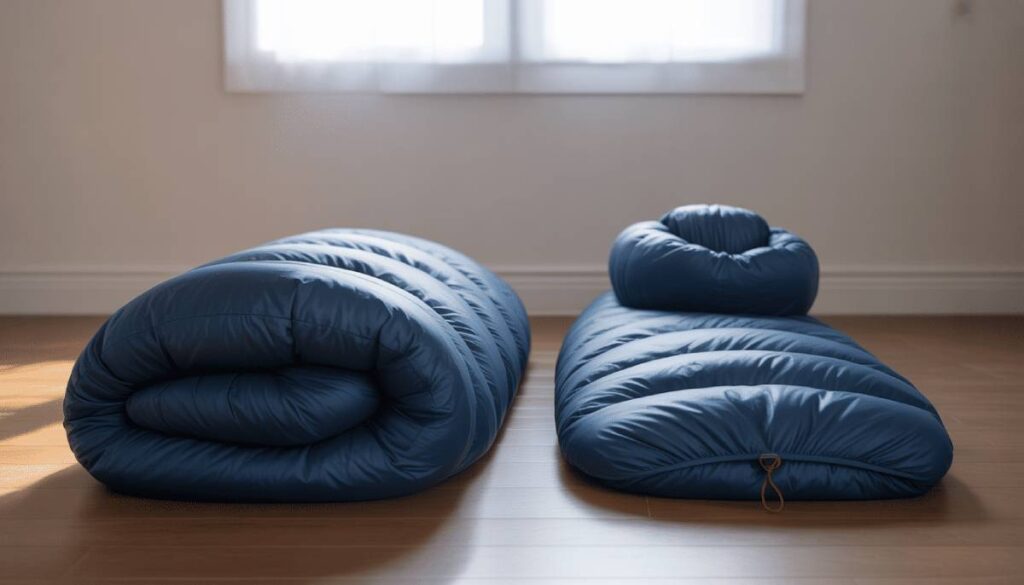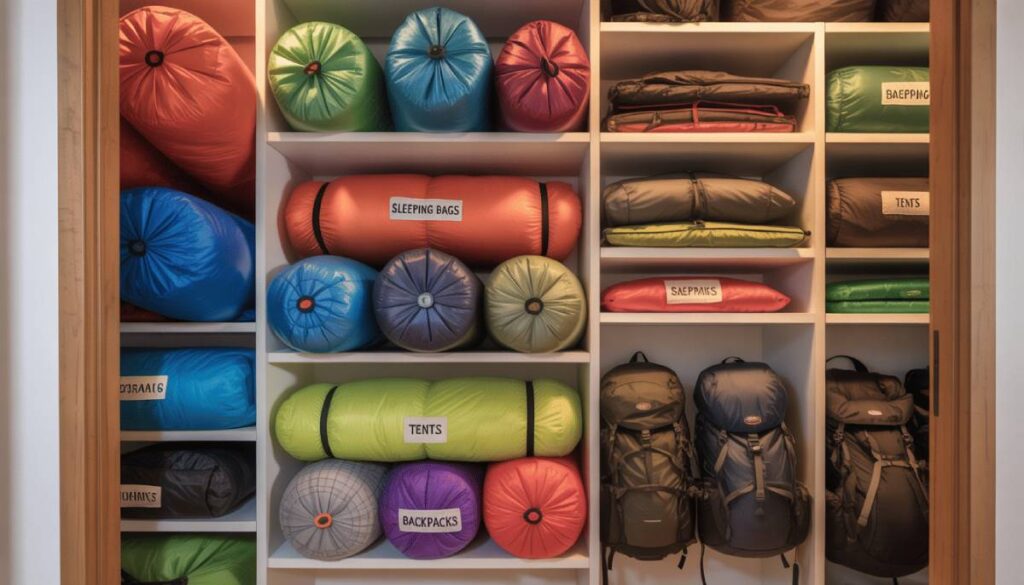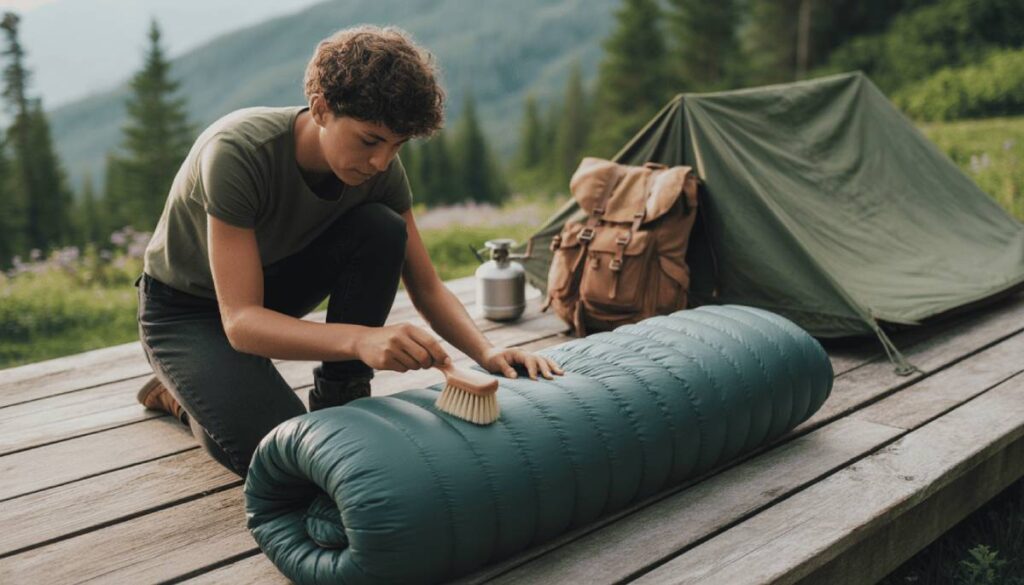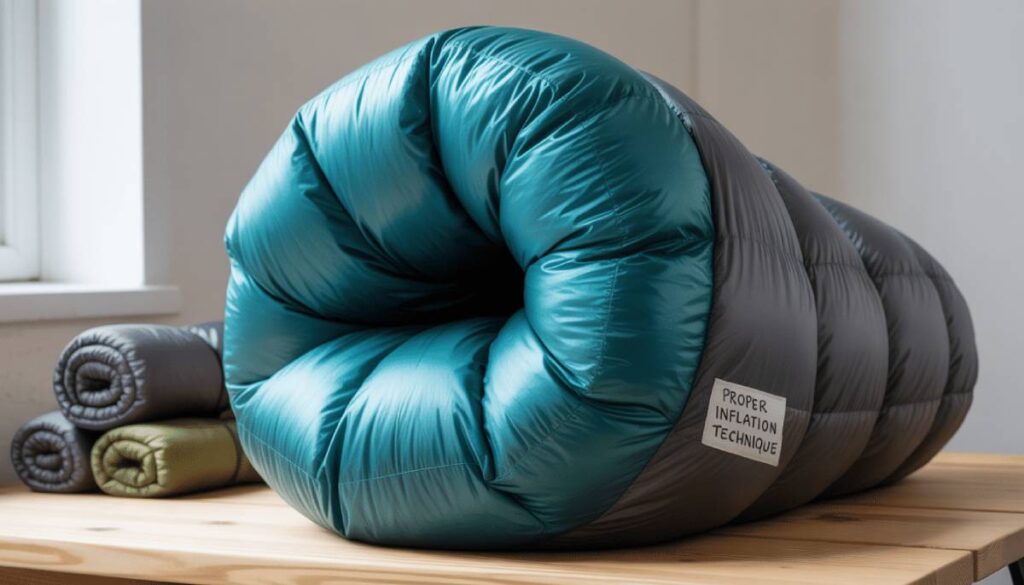Your sleeping bag is more than just camping gear—it’s your wilderness cocoon of warmth, deserving proper care between adventures. With the right storage practices, your sleeping bag will maintain its loft, warmth, and comfort for years of outdoor excursions, while improper storage can permanently damage insulation and leave you shivering on your next trip.
Key Takeaways
- Never store sleeping bags compressed in stuff sacks for long periods
- Always ensure sleeping bags are completely clean and dry before storage
- Use breathable storage sacks to maintain loft and prevent moisture buildup
- Store in cool, dry locations away from direct sunlight
- Different care techniques apply for down versus synthetic sleeping bags
- Regular inspection and maintenance extends sleeping bag lifespan
- Proper fluffing and lofting preserves insulation effectiveness
- Improper storage can significantly reduce warmth and comfort
Proper Storage Practices
Importance of Correct Storage
Keeping your sleeping bag snug as a bug (but never squished like one) is the key to its warmth and fluffiness. A cozy down sleeping bag can handle being crammed tight for a day—maybe up to 24 hours—without losing its mojo. But don’t make it a habit. These high-flyers, designed for snuggle-licious lofting, can suffer if kept in a squeeze too long. It’s like wearing your favorite shirt without washing it—a little freshening up does wonders.
Our feathered friends (their plumes, anyway) rely on staying fluffy to trap heat. Crunch them too long and—poof! There goes the warmth. Store it right and those insulation fibers will stay intact and snuggly for nights to come.
To keep your trusty sleeping bag at peak performance, make sure it’s out in its fluffy state, not crammed into a sack. Think of it as letting it breathe. So, whether it’s a sleek backpacking number or your chunky campout companion, avoid long stretches of confinement to keep it soft and warm.

Impact of Incorrect Storage
Things get dicey when your sleeping bag is compressed into a tiny sack for months on end. It can lose its puffy charm, leaving you shivering in the cold. And it’s true for both down and synthetic types, though synthetic tends to throw a bigger tantrum when squashed for too long.
Rolling or folding your bag is like cramming a pizza into a wallet—not recommended. It messes up those precious fibers and outer layers. The best move is to stuff the sleeping bag loosely, allowing it to hold its shape and keep that toasty loft intact. This way, those delicate fibers stay happy and your sleeping bag stays deluxe for the long haul.
| Storage Type | Impact |
|---|---|
| Compressed (short-term, 16-24 hrs) | No worries—down bags even enjoy this break |
| Compressed (long-term, several months) | Say goodbye to loft and warmth |
| Rolled/Folded | Risky business—fibers might not forgive you |
| Stuffed (uncompressed) | Your go-to for fluff & comfort |
Ready for bedtime perfection? Check out our guides on how to clean a sleeping bag and crack the code on down vs synthetic sleeping bags.

Cleaning and Maintenance
Who’s got a sleeping bag that needs a little TLC? If you’re aiming to cuddle up in your sleeping bag for years of comfy campouts, you’ve gotta keep it clean. Here’s the lowdown on keeping your trusty sack in mint condition.
“Your sleeping bag isn’t just gear—it’s your cocoon of warmth in the wilderness. Treat it right in storage, and it will return the favor on countless adventures.” – REI Camping Expert
Spot Cleaning vs. Full Wash
Ever dropped ketchup on your sleeping bag? Instead of a full soak, spot cleaning does wonders. Mix a little soap that’s not detergent (yeah, that’s a thing) with water to target those pesky spots. Be sure to give it a good rinse and keep the soggy stuff out of the fill so it holds up longer. If you’re itching for more deets on keeping your sleeping bag squeaky clean, pop over to how to clean sleeping bag.
Drying After Cleaning
When it comes to drying out your freshly-swabbed sleeping bag, you’ve got to let it chill out. Just air it out somewhere cool and dry for about 4 to 6 hours; that’ll keep the yucky smells away and the fluff nice and fluffy. Say no to throwing it in the dryer—trust me. For more genius ways to dry your bag, check out how to clean sleeping bag.
| Drying Method | Time Required |
|---|---|
| Air Drying | 4-6 hours |
| Tumble Drying | Nope! Don’t do it! |
Restoring Durable Water Repellent Finish
Here’s what happens: after a while, the water repellent fairy takes a hike, and your bag’s outer layer loses its superpowers. Time to zap it back to life with some of those magic sprays or washes that bring back the mojo. Your bag’s got to stay water-repellent and primed for cozy nights.
For tips and tricks on getting that water-repellency back without a hitch, wander over to best sleeping bag storage practices.
Treat your sleeping bag right, and it’ll return the favor, keeping you snug with every camping escapade.
Long-Term Storage Tips
If you want your sleeping bag to treat you well on those chilly nights outdoors, stash it the right way! Here’s how to dodge the mistakes that can still haunt those newbie campers.

Give Compression a Break
Nobody likes to feel squashed, including sleeping bags. Stuffing yours into a tiny pouch for too long can crush the fluff’s spirit – those fibers lose their warmth, and suddenly you’re blaming the zippers for everything (Long White Gypsy). Save the compression hugs for when you’re on the move.
| How to Pack It | Thumbs Up or Nah? |
|---|---|
| Stuff Sack | Great for hitting the road |
| Mesh or Cotton Bag | Perfect for hanging out at home |
Lift up your bag’s loft and let it breathe, so it’ll warm your toes for years.
Spotting the Perfect Hideout
Picking a chill and dry spot saves your bag from a tragic end. Heat and sunlight are the evil twins that can frazzle those fibers.
| What to Watch | You Got This! |
|---|---|
| Temperature | Keep it cool, like a cucumber |
| Humidity | Dry is the way to fly |
| Sunlight | No tanning allowed! |
Follow these rules to keep your sleeping companion fighting fit.
Down vs. Synthetic: Who Needs What?
Each type’s got its own quirks. Down or synthetic, both need room to stretch their legs, or, you know, loft their insulation.
Down Sleeping Bags
These bags have a fancy “downproof” thing going for them to keep feathers from escaping. Some may wiggle out anyway, but just poke those little guys back in (REI). Big, breathable storage bags are their jam.
Synthetic Sleeping Bags
Synthetic versions also need to lounge in breathable sacks. They can handle squishing better than down but don’t push your luck – no one likes a grumpy, flattened bag.
Curious about how these guys measure up against each other? Check our article on down vs synthetic sleeping bags to get the lowdown. Keep your gear snazzy with these tips, so you’re always prepped for whatever Mother Nature throws your way. Want more deets on bag types? Take a peek at types of sleeping bags.
Caring for Down Sleeping Bags
Taking care of your down sleeping bag keeps it warm and feeling like a cozy cloud. Let’s break it down with some easy hacks to keep it in tip-top shape.

Maintaining Insulation Loft
The fluff, or loft, in your sleeping bag is what makes it all cuddly and warm. It traps air to wrap you in a cozy bubble. Here’s how to keep it fluffy:
- Skip the squish: Storing your bag compressed is okay for quick trips (think less than a day), but when you’re done adventure-bound, let it breathe by keeping it loose. Prolonged squishiness squashes the fluff making it less huggable with warmth (The Great Outdoors Stack Exchange).
- Let it breathe: After a night under the stars, unzip your bag and let it catch some air to dry out, this wards off any feather clumping.
- Give it a good shake: Fluff it up every once in a while to keep those warm feathers well-spread and puffed up.
Snag more nifty tips on striking the right cleaning balance in our fun guide on how to clean sleeping bags.
Using Breathable Storage Bags
A cool sleeping bag needs a happy home. A breathable bag helps your down amigos stay fluffy and dry. Here’s what to do:
- Pick a cotton or mesh bag: These bags are fab for letting air circulate, keeping your bag fluffy. Just like wearing a nice, airy shirt on a sunny day—perfect (Puffy).
- Leave it loose: Pack away your sleeping cocoon loosely for long nap sessions between camping trips. Ditch the crunchy compression sack for long-term rest.
- Say no to tight containers: Condensation and mildew are sworn enemies of down. Keep your bag away from moisture traps and sun bake zones.
| Storage Method | Recommended? | Reason |
|---|---|---|
| Compression Sack | ❌ | Can flatten loft |
| Cotton Storage Bag | ✅ | Breathable, keeps fluff |
| Mesh Storage Bag | ✅ | Breathable, keeps moisture out |
| Watertight Container | ❌ | May cause mildew |
Want to dive deeper into the smorgasbord of sleeping bag options? Check out our pieces on types of sleeping bags and down vs synthetic sleeping bags.
Keep your sleeping bag snuggle-worthy by adding these habits to your routine. It will keep you warm and ready for new adventures! For more cozy bag wisdom, peek at our tips on best winter sleeping bags and best ultralight sleeping bags.
Sleeping Bag Inspection
Taking a peek at your sleeping bag now and then is a great way to make sure it stays cozy and comfy. You’ll want to eyeball the seams, zippers, and keep an eye out for those pesky feathers trying to escape.
Checking Seams and Zippers
The seams and zippers are like the backbone of your sleeping bag. Give them a good lookover to catch any wear and tear before things go sideways.
Inspecting Seams
Think of seams as the skeleton of your kit; they’re holding everything together. Watch out for fraying, runaway threads, or any sneaky gaps that can turn your warm refuge into a drafty nightmare. Nipping these issues in the bud can save you from a chilly surprise.
Examining Zippers
Zippers can be the Achilles’ heel of a sleeping bag. Make sure they glide smoothly and don’t throw any tantrums by getting stuck or breaking. If the teeth don’t align or there’s damage, it’s like having a door that won’t close—a problem when it’s freezing outside.
| Element | Inspection Point | Action |
|---|---|---|
| Seams | Fraying or loose threads | Secure any loose ends |
| Zippers | Ensure they move like butter | Add some grease or swap out |
Addressing Feather Leakage
Feathers sneaking out of their home are not unusual in down sleeping bags but can seriously mess with your comfort and warmth if left unchecked.
Identifying Leakage
Notice any feathers trying to make their great escape? This could leave your bag feeling a bit lacking in the insulation department, which nobody wants when the temps drop.
Managing Leakage
If you catch sight of an escapee, nudge it back in gently instead of yanking, which can widen the breach. If the feather exodus continues, you might want to call in the pros to patch things up and keep that down where it belongs.
For those interested in diving deeper into sleeping bag care:
- down vs synthetic sleeping bag
- how to clean sleeping bag
By keeping a regular check on the seams, zippers, and feather guests, you’re set to enjoy countless cozy nights in your durable sleeping bag. Stick to these tips, and you’ll be snug as a bug in a rug for adventures to come!
Preserving Bag Resilience
Keeping your sleeping bag cozy and warm isn’t rocket science, but there are a couple of tricks to keep in your back pocket. The key secrets—fluffiness and avoiding the dreaded insulation slump—can make all the difference between a shiver-filled night and a snug snooze.

Fluffing and Lofting
A fluffy sleeping bag is like a big, warm hug. It’s all about those little air pockets that trap your heat and keep the cold at bay. Whether it’s feathery down or trusty synthetic, fluff them up to maintain that warm cocoon you’re aiming for.
To keep things puffy:
- Skip the squeeze: Don’t squash your sleeping bag into a tiny stuff sack and leave it there for ages. Too much squeezing crushes its spirit, and you’ll end up with a cold, flat lump. Instead, let it breathe in a roomy spot (REI).
- Shake it out: After you liberate it from the sack, give your bag a gentle shake. This will bring back that inviting loft, setting the stage for a warmer night.
- Breathy bag storage: For resting time, a loose-fitting cotton or mesh sack is your bag’s best buddy. It keeps everything airy and avoids cramped quarters, making sure it stays fluffy (Long White Gypsy).
| Storage Style | Effect on Fluffiness |
|---|---|
| Squished in tiny sack | Flat and lifeless |
| Cozy in a cotton/mesh sack | Puffy and ready to warm |
Insulation Settlement
Insulation can get lumpy if it’s pushed around too much, leaving you with chilly spots. Whether your spendy down or your loyal synthetic, no fill is immune to this squished, uneven fate after being smooshed or ignored.
Here’s how to avoid the slump:
- Flip and shake: Every now and then, give your bag a little love with some gentle patting and fluffing. This helps the fill spread out evenly; no cold toes for you!
- Breathable sacks: Stick your bag in a breathable sack of cotton or mesh, the magic well-ventilated bags boost fluff and stop wet from ruining the works (REI).
- Stuff, don’t roll: When you’re packing, stuff your bag rather than rolling it like a burrito. Stuffing helps the bag keep its shape and protects those delicate insides (Long White Gypsy).
Keep these tips in mind, and you’ll not only bolster your bag’s snuggliness but also extend its life and performance. If you’re thirsty for more on sleeping bag wisdom, why not check out our guides on types of sleeping bags and the best 3 season sleeping bags?
Avoiding Mold and Mildew
Keeping mold and mildew out of your sleeping bag is a smart move for making sure it sticks around and works like a charm. Here’s the low-down on how to keep those pesky problems at bay.
Drying Techniques
Getting your sleeping bag bone-dry is the secret sauce to stopping mold and mildew from cozying up in there. Always let it dry all the way after you’ve crashed in it or given it a good clean.
- Unzipping and Hanging: Zip that bag open and drape it over a line or big hanger in a covered outdoor spot for like 6 to 8 hours. Keep it out of direct sun, or you might see those colors fade faster than a bad tan (REI).
- Inside Out Drying: At first, turn the bag inside out to help dry, especially if it’s got a waterproof layer. Moisture will sneak out faster this way. Flip it back halfway through just to be thorough.
- Air Fluff: Go for the air fluff setting on your dryer without heat for about 20-30 minutes—just enough to kick out any leftover damp spots.
Need a bit more on caring for your sleeping bag? Here’s the how to clean your sleeping bag guide to give you the full scoop.
Preventing Moisture Build-Up
Proper storage is your go-to move to keep moisture out of your sleeping bag and avoid those gross mold smells.
- Temperature-Controlled Storage: Find a spot that’s cool, dry, and not too humid. The garage or attic just ain’t it. Pick somewhere stable away from direct sunlight (REI).
- Use Breathable Bags: Slip your bag into a large cotton or mesh sack so it can breathe—no squishing! If you’re fresh outta special bags, a king-size pillowcase does the trick too (Long White Gypsy).
- Regular Inspections: Keep an eye on your sleeping bag like you do with your pet – look for any signs of dampness or mildew. Check zippers and seams, and don’t forget those spots where the insulation tends to gather.
| Storage Location | Bad Habits to Kick | Good Places to Use |
|---|---|---|
| Basement | Soaked corners | Cool, dry, low-humidity areas |
| Attic | Hot and cold swings | Cool, stable temperature zone |
| Garage | Whatever-the-weather | Inside a closet, airy space |
Looking for more on picking prime storage spots? Check out our reads on long-term storage tips and sleeping bag temperature rating.
Stick to these drying tricks and storage smarts, and your sleeping bag will stay fresh and ready whenever you’re off on your next camping trip!
Best Practices Recap
Here’s a quick lowdown on keeping your sleeping bag in tip-top shape. Whether you’re just pitching a tent on the weekends, feel like a packhorse hauling gear for miles, or camping in the middle of a snowstorm, these tips will keep your sleeping bag cozy and warm for many moons to come.
Storing for Longevity
Hang tight! Here’s how to make sure your sleeping bag stands the test of time:
- Steer Clear of Long-Term Compression:
- Stuffing a down sleeping bag into a tiny sack for a few hours is okay, but don’t make it a habit. Over time, flattening it can do a number on those insulation fibers, leaving you shivering on a chilly night (The Great Outdoors Stack Exchange).
- For travel, short squishes are fine. But leave it like that too long, and you might regret it the next time you’re out camping in the cold (Long White Gypsy).
- Let it Breathe:
- When it’s time for a nap for your bag, get it out of that compression sack! Everyone needs room to breathe, and so does your sleeping bag. A big ol’ cotton or mesh sack will let it puff up just right (Puffy).
- Cramming it away for months? Nope, not today! Your bag may lose its loft and warmth if kept stuffed too long (REI).
- Pick the Right Spot:
- Choose a chilled out, dry location. Skip any place damp or scorching hot, or you could end up with a damp, musty bag.
| Storage Type | Duration | What’s the Impact? |
|---|---|---|
| Compressed (travel) | Up to 24 hours | Not much |
| Compressed (long-term) | Months | Big bummer on warmth |
| Uncompressed (long-term) | Indefinite | Keeps it cuddly |
Tips and Recommendations
A few more handy nuggets of advice can really help your sleeping bag live a long, warm life:
- Go for Breathable Bags:
- Those fancy down sleeping bags deserve a nice airy home. Cotton or mesh bags fit the bill, making sure moisture doesn’t invite mold to the party.
- Synthetic pals enjoy the same benefits. Mushrooms and mildew? No, thanks.
- Clean It Up:
- Nobody wants to sleep in the dirt. Before tucking it away, give your sleeping bag a good scrub. Need help? Check out our step-by-step on cleaning sleeping bags.
- Dodge the Sunshine:
- The sun’s not always your friend. Keep your sleeping bag shaded, away from the harsh rays, which might break down the fabric like day-old bread.
- Spot Checks:
- Give it a once-over now and then. Inspect zippers, seams, and any damage. Quick fixes will save headaches later.
Want more nerdy details on your kind of sleeping bag or picking the best ultralight option? Our detailed stories on types of sleeping bags and best ultralight sleeping bags have got you covered.
Follow these tips and your sleeping bag will be your best road-trip buddy. Here’s to many warm nights under the stars. Have a blast!
Conclsuion
Proper sleeping bag storage is more than just a minor detail—it’s the difference between gear that lasts for decades and equipment that fails when you need it most. By following these simple but critical practices, you’re protecting your investment and ensuring countless comfortable nights under the stars. Remember that your sleeping bag’s insulation—whether down or synthetic—relies on maintaining its loft to trap warm air effectively. Storing it uncompressed in a breathable container, keeping it clean and dry, and placing it in a cool, dark location will preserve its performance season after season. The few extra minutes it takes to properly store your sleeping bag between adventures will reward you with reliable warmth and comfort for years to come, making those magical wilderness experiences all the more enjoyable. After all, there’s nothing quite like ending a day of outdoor exploration by crawling into a perfectly lofted sleeping bag that feels as warm and inviting as the day you bought it.
FAQs About Sleeping Bag Storage
How long can I keep my sleeping bag in its compression sack?
While it’s fine to keep your sleeping bag compressed in its stuff sack during travel (up to 24 hours), long-term storage in a compressed state can permanently damage the insulation. Always use a large, breathable storage sack for extended periods between camping trips.
Does improper storage affect both down and synthetic sleeping bags?
Yes, both down and synthetic bags can be damaged by improper storage, though in different ways. Down tends to clump and lose loft when compressed or exposed to moisture, while synthetic insulation may break down and flatten permanently when kept compressed for long periods.
How do I know if my sleeping bag has been damaged by improper storage?
Signs of storage damage include reduced loft (fluffiness), cold spots where insulation has shifted or compressed, visible mold or mildew, and a general inability to retain warmth. If your bag doesn’t puff up after being unpacked or feels thinner than normal, it may have been damaged.
Should I clean my sleeping bag before storing it?
Yes, it’s best to ensure your sleeping bag is clean and completely dry before long-term storage. Body oils, dirt, and moisture can degrade the materials over time. Spot cleaning for minor soiling is recommended, with full washing only when necessary.
What’s the best way to restore loft in a compressed sleeping bag?
To restore loft, shake the sleeping bag vigorously and lay it flat in a dry, warm room for several hours. You can also tumble dry it on low heat with clean tennis balls to help break up clumped insulation. For down bags, this process may need to be repeated several times.
Resources
- REI Expert Advice: How to Store a Sleeping Bag
- Backpacker Magazine: Sleeping Bag Care Guide
- National Outdoor Leadership School: Equipment Care
- Leave No Trace: Equipment Care Principles
Final Thoughts
Storing your sleeping bag correctly is as crucial as selecting the right tent or backpack for your adventures. By following these guidelines, you can protect your investment and ensure your sleeping bag continues to provide cozy, reliable warmth on many trips to come.2
Proper sleeping bag storage is one of those outdoor skills that separates novice campers from seasoned adventurers. While it might seem like a small detail in your overall gear maintenance routine, it can make the difference between a sleeping bag that lasts for decades and one that needs replacement after just a few seasons. By implementing these storage best practices, you’re not just preserving an expensive piece of equipment—you’re ensuring that your future outdoor experiences will be comfortable, warm, and worry-free. Remember that a well-maintained sleeping bag is more than just camping gear; it’s your shelter within a shelter, your cocoon of warmth in the wilderness, and deserves the care that such an important companion merits.
Recommended Products for Sleeping Bag Care and Storage
- Sea to Summit Mesh Storage Bag – Extra-large breathable mesh bag perfect for storing sleeping bags while allowing maximum airflow, preventing moisture buildup.
- REI Co-op Hanging Storage Sack – Features a sturdy hanging loop and durable cotton construction for vertical storage, saving valuable closet space.
- Nikwax Down Wash Direct – Specially formulated cleaner for down sleeping bags that maintains insulation properties while cleaning.
- Gear Aid Tenacious Tape – Perfect for quick repairs of small tears or holes in sleeping bag shells before storage.
- Coleman Mesh Storage Bag XL – Budget-friendly large mesh storage solution that allows sleeping bag insulation to remain fully lofted.
- OXO Hanging Drying Rack – Ideal for thoroughly drying sleeping bags before storage, preventing mold and mildew.
- Woolite Gentle Fabric Wash – Non-detergent cleaner excellent for spot cleaning sleeping bags without damaging delicate materials.
- Mountain Hardwear Storage Sack – Premium breathable cotton storage bag designed specifically for high-end sleeping bags.
- Cedar Blocks Natural Moth Repellent – Place these in your storage area to naturally deter moths and other pests from damaging sleeping bags.
- Bounce Fabric Softener Sheets – Help eliminate odors when placed inside stored sleeping bags (use unscented varieties for sensitive skin).








